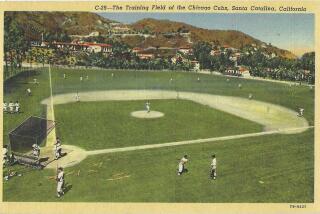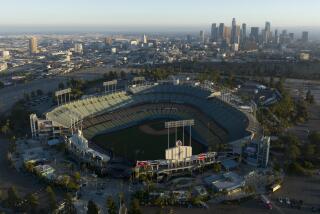Roger Bossard Is on Familiar Ground When Tending Turf at Comiskey Park
- Share via
CHICAGO — If the Chicago White Sox don’t win the American League pennant this season--and chances are good they won’t--don’t blame Roger Bossard and his team.
You won’t find Bossard on the scorecard of Sox games, nor will you hear much about what he does for the club.
But in the mind of Sox Manager Tony LaRussa, Bossard and his “team” are worth several victories a year for his club and certainly contributors to any semblance of contention in September.
Bossard is the chief groundskeeper at Comiskey Park, oldest park in the majors which celebrates its 75th anniversary this month. Bossard is one of several in his family that has been tailoring grounds in major league ballparks for two generations.
“I’ve never seen our ballpark look any better. More importantly, what Roger does to tailor the field for our needs makes him a very valuable member of the Sox team,” LaRussa said.
Bossard usually arrives at the ballpark at 6 a.m. on day games, 10 a.m. for night games. He can be seen shirtless with a shovel, fine tuning the regulation surface on the infield or inspecting a plot of sod in extreme right field.
“I know (former White Sox owner) Bill Veeck used to say that a good groundskeeper is worth 10 to 12 games a year,” Bossard says. “I like to think that we are worth that much to this team.”
Bossard does not hide one secret; he talks to the Sox infielders to find out how they like the ground and turf around their area. If Julio Cruz likes it extra smooth in front of second base, Bossard will make sure the rake is that much firmer in its pre-game strokes.
“That’s part of the homefield advantage,” Bossard explains. “We may have a certain part of the infield one way or a certain player likes it other way, we’ll do it. It’s legal.”
LaRussa insists he wasn’t aware of the tailor job done by Bossard in his crew.
“All I know is this guy is the best in the business and it has helped us,” LaRussa says.
Comiskey Park has hardly been a haven for Bossard and his crew. Before the current owners--Jerry Reinsdorf and Eddie Einhorn--bought the club, Comiskey park was regarded as one of the worst playing surfaces in the American League.
The main problem was the archaic drainage system. Rains would come down and instead of finding a way out of the outfield, they would stand in huge pools of water.
“Unfortunately when Bill Veeck was on the club we didn’t have the kind of funding that we do have now,” Bossard says. “What we have been able to do is improve the drainage system, get new sod, and have the type of funding for the equipment to make this one of the best parks in the majors.”
“Not one of the best parks, the best,” LaRussa adds. “Our infield and outfield is in better shape than any park I’ve seen.”
Comiskey Park hasn’t always had the regular turf. During the early 1970s, artificial turf adorned the playing surface before Veeck ripped it out when he took over the club in 1975.
Artificial turf and Bossard are hardly friends.
“I don’t like it, never have,” Bossard says. “It has little to do with preparing the field. Baseball is better on regular turf. There are still things a grounds crew has to do on the parts with artificial surfaces. But there is a challenge to keep our place up to standards and I just think baseball was meant to be played on regular turf.”
That wasn’t the case in Saudi Arabia where Bossard helped construct a national soccer stadium with funding from the coy’s royal family.
“A little different situation when you start from scratch in the desert,” Bossard says. “It also is a different situation when you are talking about a facility expressly designed for soccer and not baseball.”
Bossard’s father who once ruled the roost at Cleveland’s Municipal Stadium, taught Bossard most of his “tricks.” He also taught him about hard work.
“I get to the park many times before the sun comes up,” Bossard says. “In a way it’s like taking care of your own garden or lawn. The more care you put into it, the better it is going to look. It’s the same here except on a much, much larger scale. I love it.”
More to Read
Go beyond the scoreboard
Get the latest on L.A.'s teams in the daily Sports Report newsletter.
You may occasionally receive promotional content from the Los Angeles Times.










